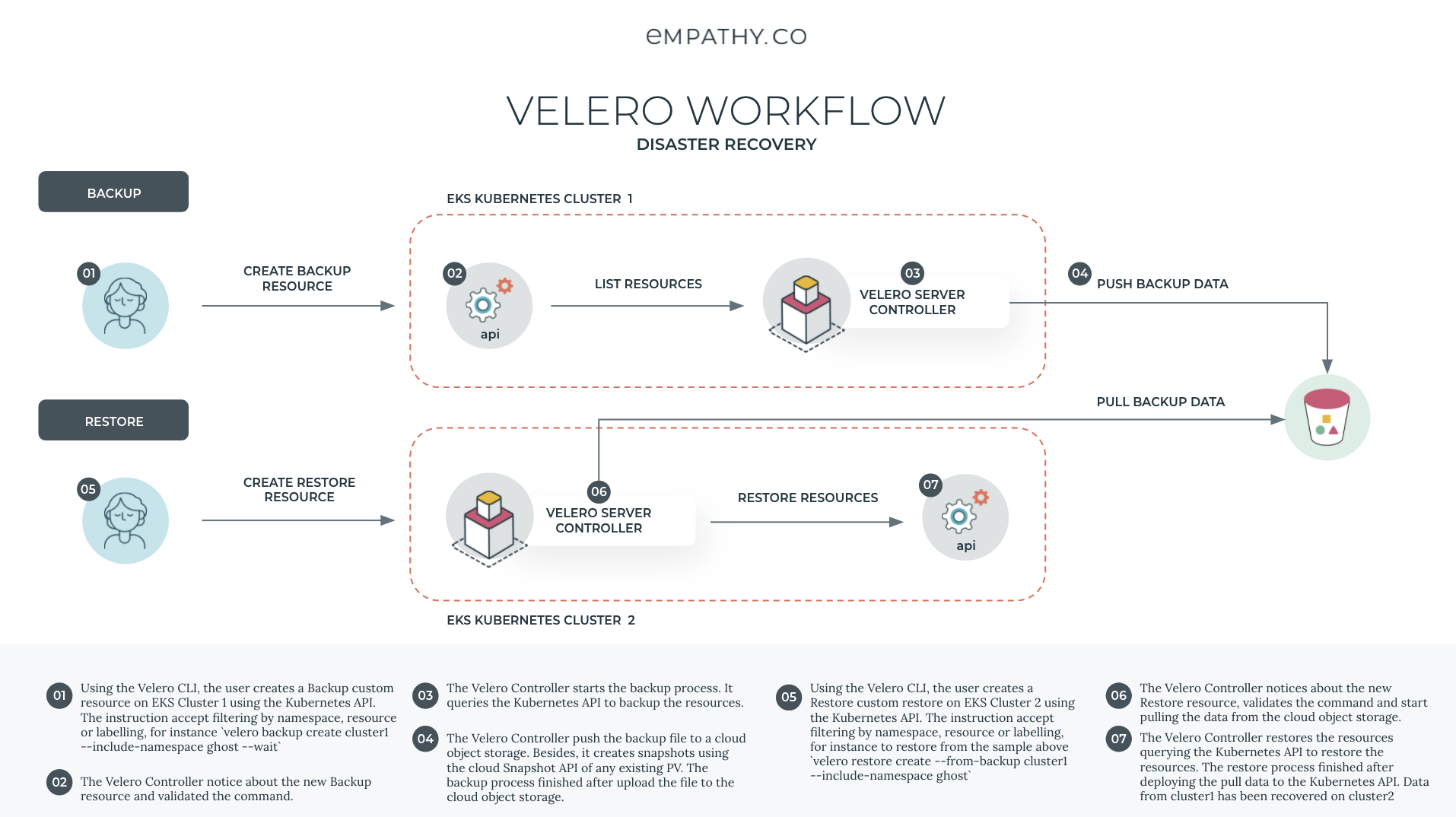Kubernetes Backup and Migration Strategies with Velero
The motivation of this repository is to show some Velero use cases:
- Disaster recovery
- Data migration
In this repo a disaster recovery on EKS will be tested and a data migration between EKS and GKE will be showed.
Generic Velero workflow is as follows:

- AWS
- Cluster creation
- A backup location
- IAM Permissions
- Initial Status
- GCP
- Cluster creation
For testing reasons, this is done using AWS CLI and GCLOUD CLI.
For the backup location a S3 bucket should be created:
# Remember to specify
# BUCKET="k8s-days-backup"
# REGION="us-west-1"
aws s3api create-bucket \
--bucket $BUCKET \
--region $REGION \
--create-bucket-configuration LocationConstraint=$REGION
Velero workloads need permissions to interact with the Snapshot API from AWS and the S3 bucket. An AWS user will be created with an access key.
cat > velero-policy.json <<EOF
{
"Version": "2012-10-17",
"Statement": [
{
"Effect": "Allow",
"Action": [
"ec2:DescribeVolumes",
"ec2:DescribeSnapshots",
"ec2:CreateTags",
"ec2:CreateVolume",
"ec2:CreateSnapshot",
"ec2:DeleteSnapshot"
],
"Resource": "*"
},
{
"Effect": "Allow",
"Action": [
"s3:GetObject",
"s3:DeleteObject",
"s3:PutObject",
"s3:AbortMultipartUpload",
"s3:ListMultipartUploadParts"
],
"Resource": [
"arn:aws:s3:::${BUCKET}/*"
]
},
{
"Effect": "Allow",
"Action": [
"s3:ListBucket"
],
"Resource": [
"arn:aws:s3:::${BUCKET}"
]
}
]
}
EOF
aws iam create-user --user-name velero
aws iam put-user-policy \ --user-name velero \
--policy-name velero \
--policy-document file://velero-policy.json
aws iam create-access-key --user-name velero
# Deploy a EKS Cluster using eksctl called cluster1
eksctl create cluster -f aws/cluster1/cluster.yaml
# Install Ghost workloads
cd workloads/ghost
# Initial Ghost
helm install --create-namespace -n ghost -f values.yaml ghost .
# Install Velero workload
cd workloads/velero
helm install --create-namespace -n velero -f values.yaml velero .# Deploy cluster3
gcloud container clusters create cluster3 \
--zone europe-west1-b \
--node-locations europe-west1-b \
--disk-size=10GB \
--preemptible \
--num-nodes=3 \
--machine-type=n2-standard-2Everything can fails, and Velero help us to recover from a disaster recovery. For this sample, the goal will be recover a namespace in other EKS cluster from a previous Velero backup. A sample diagram would be as follows:
# Deploy a EKS Cluster called cluster2
eksctl create cluster -f aws/cluster2/cluster.yaml
# Make a backup on cluster1
velero backup create cluster1 --include-namespaces ghost --wait
# Review backup status on cluster1
velero backup describe cluster1 --details
# Restore backup on cluster2
velero restore create --from-backup cluster1 --include-namespaces ghost
# Review restore status on cluster2
velero restore describe xxxx
# Check workloads restored
Sometimes for business reasons, data should be migrated between cloud providers. Because the snapshot API between the different cloud providers doesn't interact between each other an agnostic layer is needed. Restic help us to provide this file system level agnosticism and allow interact file system between cloud providers.
A sample workflow would be as follows:

# Upgrade Velero with Restic on Cluster2
helm upgrade -f values-restic.yaml velero .
# Create a backup
velero backup create cluster2 --include-namespaces ghost --wait
# Review detailed backup status
velero backup describe cluster2 --details
# Install Velero with Restic on Cluster3
helm install --create-namespace -n velero -f values.yaml velero .
# List backups on cluster3
velero get backups
# Restore from backup on cluster3
velero restore create --from-backup cluster2 --include-namespaces ghost
# Check workloads restored
kubectl get po -n ghostThe slides can be found here
